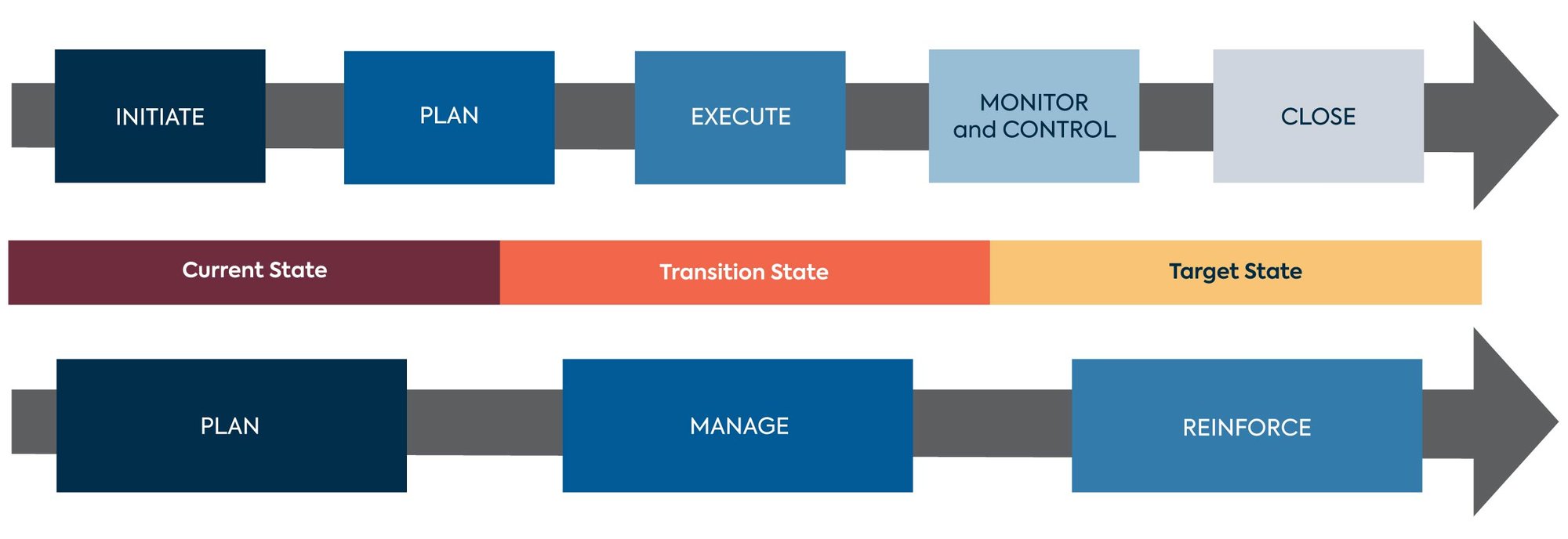KNOWLEDGE CENTER
Change Management And Project Management
Change management is the management of a change in resources, process, and people involved in a project. Sometimes, organizations will face a challenge that requires change management in a project. A simple example of change management within project management is if a team had 12 months to finish a project, but a month in, the timeline was cut down to eight months. The team would then need to manage the change and make sure the project is done on the new timeline with all the resources necessary to finish the project to the expected quality. To tackle these difficult situations, many organizations seek the help of a change management consultant to act as the expert.
What Is the Difference Between Change Management and Project Management?
Change management and project management can overlap to work together in harmony; they are not the same thing, nor were they designed for the same purpose. The goal of project management is to complete or achieve the end result of the project. Change management is more similar to a mechanic fixing tools other people use so other workers can continue their jobs. A change manager must figure out solutions and fixes to changes that affect other people rather than focusing on a single end goal. There are too many nuanced and detailed differences between project management and change management to list everything, but the most important ones are listed below.
PROJECT MANAGEMENT: the technical side

CHANGE MANAGEMENT: the people side
Project Management
- The identification of stakeholders’ needs – Project managers are responsible for managing everyone who is involved in the project or have a vested interest in the outcome, aka stakeholders, and ensuring needs are met across the board, otherwise, the project can derail.
- Smart project objectives: Project objectives should be specific, measurable, attainable, realistic, and timely, as any goal outside those parameters is less manageable.
- Clear deliverables and deadlines – A deliverable would be an increase in daily traffic, and the deadline would be the data by which the deliverable must be realized.
- A detailed project schedule: A detailed schedule would include stages or progress and checkpoints to ensure the project is on track to meet the final deadline.
- Defined roles and responsibilities: Each person needs to know their role and what their job is within a project; otherwise, lines can be crossed, and instructions can conflict, which stalls the entire team.
- Project costs that help identify shortfalls: Project managers are responsible for making a planned budget and managing the project, so it stays within the projected budget.
- A communication plan that keeps the project moving forward – Communication is critical to keep a system moving as one team relies on a different team to finish their work, but none of that information will be passed along without a communication plan from leadership.
- The right process and systems to track and manage projects – The systems to track and manage the teams must encompass other necessary elements to keep the process flowing. Communication, tracking timelines, planning tools, access, and visibility all fall under a project process plan.
Change Management
- Acknowledge and understand the need for change: Change is unavoidable, but it is up to change managers to ensure the changes go as painlessly as possible, so everyone else can keep doing their jobs.
- Communicate the need and involve people in developing the change – People want to understand why things are changing and how it will affect them, which means communication is absolutely vital in navigating changes.
- Develop change plans – Precise and exact plans should include your goals, objectives, and performance measurements so you can tell if the change plan is on track or if more change is coming.
- Implement change plans – Finally, implementing change plans is a stressful period, but change managers should be there to reassure and support people as the change takes place.
- Evaluate progress and celebrate success: Evaluate the change process, how people react, and the performance measurements to see if the change is on track as soon as you can. Once the system seems to be taking well, thank people for cooperation and hard work so everyone can celebrate the success together.
Change Management Consulting
Change Management consulting supports organizations in managing the transformation they are expected to experience in the log run. Sometimes, the world will throw something unexpected your way, but a change management consultant from SkillSource Learning Partners can make the transition less daunting. As experts in change management strategy, our qualified consultants will help you navigate whatever challenges you and your organization might face. Reach out to us online to open a dialogue with a SkillSource representative and discover how our change management services can improve your organization’s ability to survive the unexpected.
Why Do Businesses Need an Effective Project Management and Change Management Strategy
In the absence of a well-defined course of action, endeavors in change management and project management can swiftly descend into chaos and ambiguity. However, employing a management model or methodology can protect a business from disorder. It is advisable for businesses to leverage the extensive range of project management and change management strategies available. These structured models serve as guidance and establish a transparent roadmap, ensuring that all stakeholders remain aligned and informed.
Types of Change Management
There are a few different types of change management, and each type is best suited to a particular use case or situation. However, the general industry consensus is that there are four main types, each of which can be adapted, modified, and or tweaked to suit an organization’s needs as project management is not always a straight line.
-
Anticipatory

This type of change management involves planning the changes before they happen. Anticipatory planning happens when there is a general idea or likelihood that change will happen in the near future, so change managers start working on the project beforehand. This type of change management is helpful when someone is planning to retire soon, and the job still needs to be filled, so change managers will start planning ways to make everything work.
-
Reactive
The reactive approach to change management means that the change was unforeseen and must be managed on the fly. This type of change happens when no one saw an event coming, there is little time to make a plan, so managers must think fast to find a new solution. No one wants reactive change management to be necessary, but life will always throw unforeseen events at us, and reactive change management is there to help when it happens.
-
Incremental
This type of change management is best suited for gradual change that happens over a period of time. Many incremental changes are small but are still intricately connected to the success of the overall project. Incremental changes can be the plan to add new features to your website over time, and while these changes are unlikely to upend or derail entire projects, they should still be handled correctly, so incremental changes do not become reactive changes.
-
Strategic
These types of changes are much more impactful and can affect the direction of the entire project or company as a whole. A strategic change could be adding new technology, which requires new documentation, training, workflows, and maybe even new team members. This level and scale of change is significant and must be handled correctly to get everyone back on track with the changes.
How SkillSource’s Change Management Consultants Can Help You Navigate Business Transitions
Project management and change management might sound like a complicated dance for any company to get right, but it is possible. There is a difference between project management and change management tools, but they work together well to help everyone reach their goals in the best way possible. While these management tools are necessary, they can also be difficult to use correctly. Change and project management are critical systems that need the right people at the wheel to make the right decisions, but outside help from SkillSource can be the perfect lighthouse. A change management consultant from SkillSource has the expertise necessary to help any organization make the best management choices. Contact SkillSource today to learn how change management consultants can help your business navigate any challenge it faces.
Activities That Our Project Management and Change Management Consultants Typically Perform
Analysis
- Aligning projects to business goals.
- Defining strategy.
- Identifying risks and potential obstacles for key stakeholders.
Creation
- Building comprehensive Change Management or Project Management plans.
- Creating timelines.
- Creating Communications plans.
Implementation
- Managing teams, budgets, communications and/or deadlines.
- Identifying gaps and solutions to address areas of resistance.
- Communicating clear objectives and the “how” of meeting each objective/deliverable.

